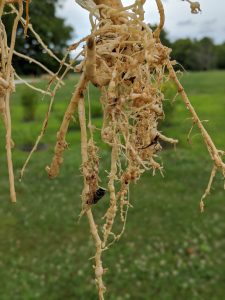On a sandy hillside in a watermelon field, we noted vines that, from a distance, appeared undersized compared to the vines in the flats. Upon closer inspection, some of the vines had either wilted or a portion of the plant had wilted. The wilted vines had discolored vascular tissue. These vines were affected by Fusarium wilt of watermelon. The roots of many of the plants had galls caused by root knot nematodes. That is, many of the vines were infected with both Fusarium wilt and root knot nematode. This article discusses root knot nematode on watermelon.
Root-knot nematodes are small, colorless roundworms that dwell in the soil. They penetrate into plant root in the juvenile stage. Once they find a favorable location in plant tissues, they stop moving. Infested root cells start swelling and form galls that are the characteristic symptom of root-knot nematode infestation (Figure 1). Infested roots fail to absorb water and nutrients resulting in stunted growth, yellowing and wilt of above ground plants. Going through their life cycles, mature females lay eggs on root surfaces.

Figure 1: Root knot nematode damage on watermelon includes the galls on the roots seen here. The vines may be stunted and the yields may be reduced.
Root-knot nematode thrives best in well aerated, moderately dry soils; it is a problem in regions where winter is not harsh enough to kill root-knot nematode eggs. It causes damage on cantaloupe and watermelon. Movement of root-knot nematode in soils is extremely slow. Contaminated tools and plant materials, feet of human and other animals and rain or irrigation water may move nematodes. Once soils are contaminated, root-knot nematode populations increase quickly with the presence of host plants, and favorable soil conditions, i.e. warmth, moisture, and oxygen.
Good cultural practices can effectively prevent or reduce damage caused by root-knot nematode. The first step is to prevent soil contamination. Carefully clean and sanitize any tools and tractors, shovels etc.
Soil fumigation is by far the most effective approach to control nematodes, but many soil fumigants may be considered too expensive. Fumigants include Telone (1,3-dichloropropene) and Vapam HL (metam sodium). Telone may be combined in formulations with chloropicrin. Non-fumigants include Velum Prime (fluopyram) which may be put through the drip, Vydate (oxamyl) and Nimitz (fluensulfone).
Dry fallowing and cultivation to bring as much soil as possible to the surface are effective in killing root-knot nematode through starvation and desiccation. It is very important to keep the field weed-free during fallowing. Dry fallowing and tillage, however, are destructive to soil fertility. Composts and other organic materials should be added to the soil following fallowing to restore soil fertility.
Using crop rotation to control root-knot nematode is difficult because of the wide host range of root knot which includes soybeans. Be cautious that some of the cool season legume cover crops such as hairy vetch and crimson clover are also hosts of root-knot nematode; they may encourage populations of root-knot nematode under high soil temperatures. Various Brassica species that can release toxic compounds after breakdown have nematicidal effects. However, results of growing cover crops as biofumigant to control root-knot nematode is mixed because these crops may be hosts of root-knot nematode, resulting in a population increase during cover crop cultivation when conditions are favorable.
As discussed earlier, the watermelon plants observed were infected both with Fusarium wilt and root knot nematode. It is possible that the root knot nematode may increase infection of Fusarium wilt. Therefore, watermelon crops planted in fields with both root-knot nematode and the Fusarium fungus may face yield losses greater than the losses from either disease alone. It is a good idea to know the disease history of the fields you plan to plant to watermelon.